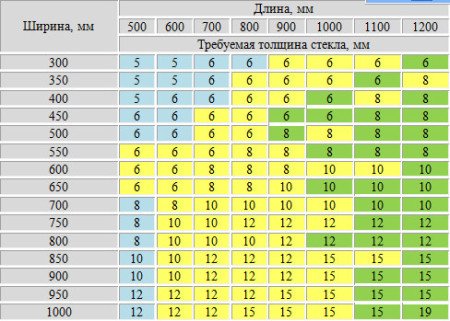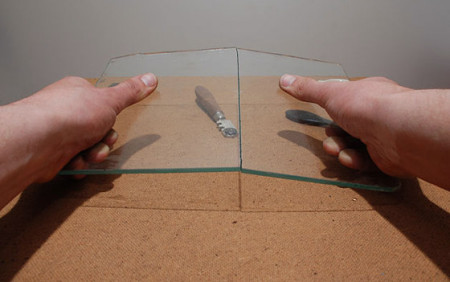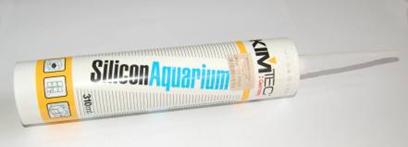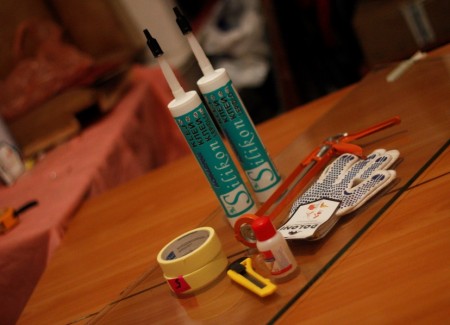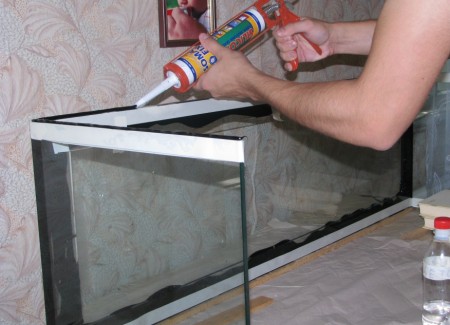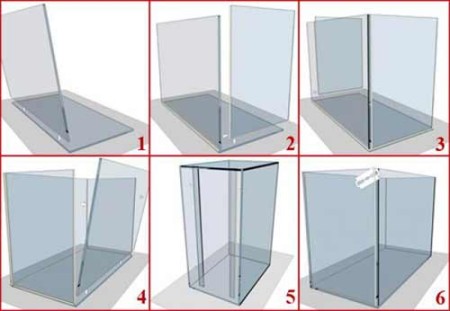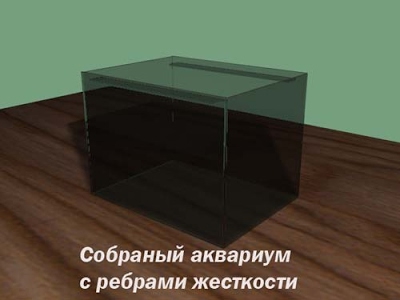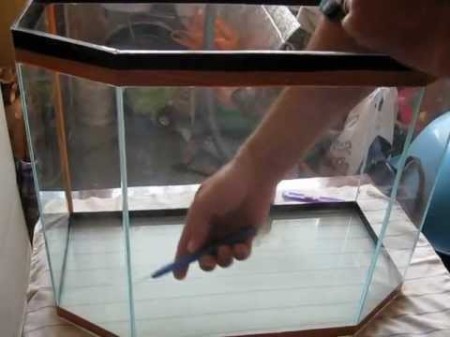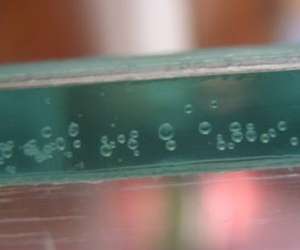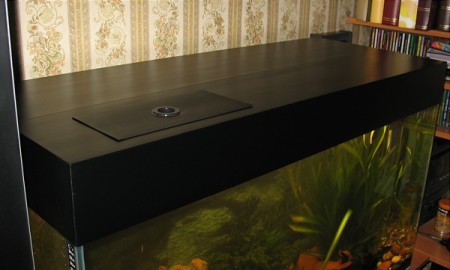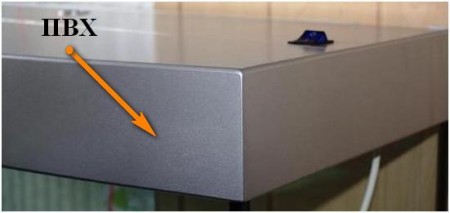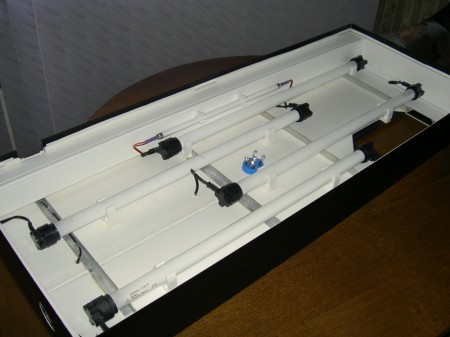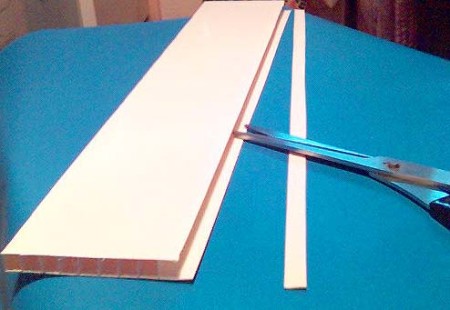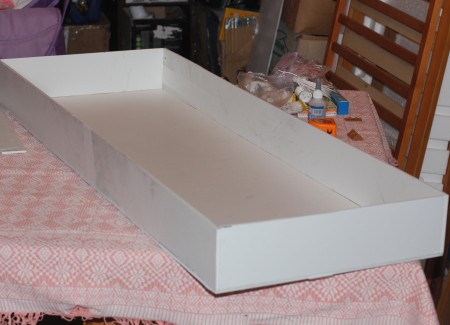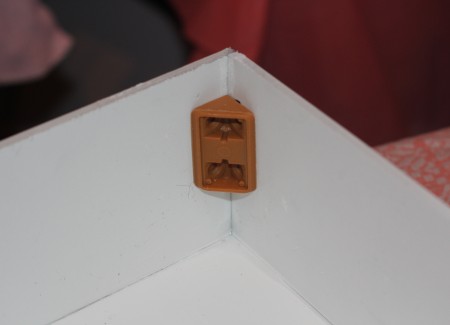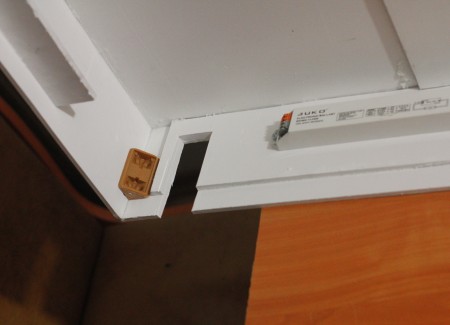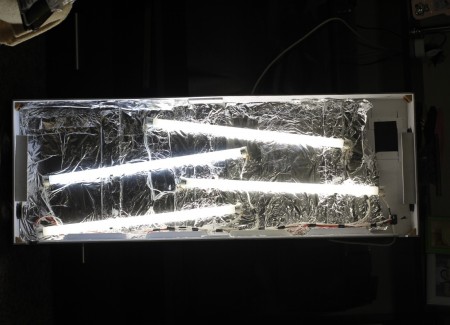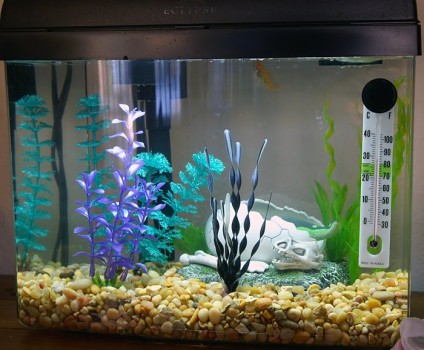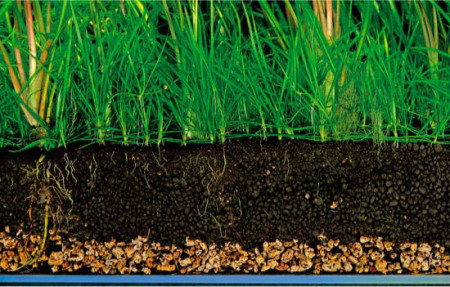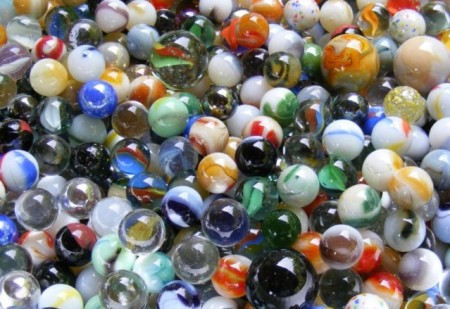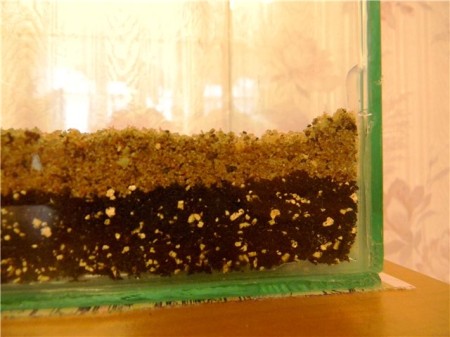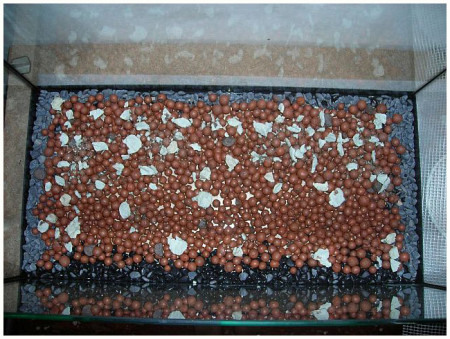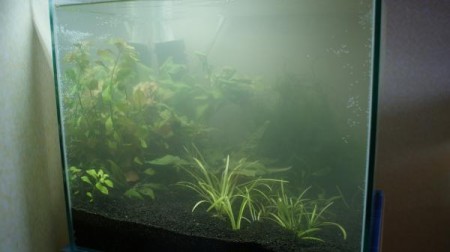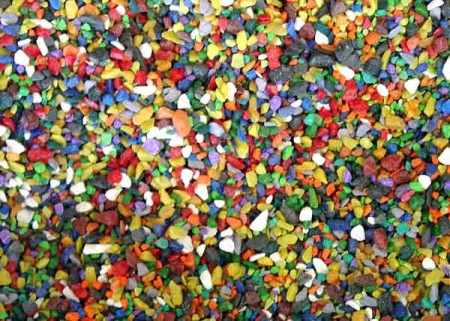Probably, many of the aquarium lovers at least once wanted to try their hand at making the aquarium themselves. There may be several reasons for this: aquariums are expensive, and the models offered by pet stores may not fit in size and shape. Making a glass aquarium with your own hands is not very difficult. The main thing in this business is to choose the right material, the minimum skills of working with glass, accuracy and exact adherence to instructions.
Within the framework of this publication, we will describe in detail how to make an aquarium with your own hands, what tools and materials will be needed.
Content
- 1 How to choose a glass for an aquarium, useful tips
- 2 Glass cutting, glue selection
- 3 We glue the aquarium: supplies, tools
- 4 We glue the aquarium with our own hands: the algorithm of actions
- 5 How to correct errors
- 6 How to make a lid for an aquarium
- 7 Backlight for aquarium
- 8 Choose a filler for the aquarium
- 8.1 natural aquarium primer
- 8.2 glass ground
- 8.3 layered soil
- 8.4 expanded clay
- 8.5 garden chernozem
- 8.6 artificial ground
How to choose a glass for an aquarium, useful tips
This is a very important point - the glass depends directly on the functionality and durability of the future aquarium. Glass grades are designated, depending on the quality, by markings from M1, to M8. It is strongly recommended that the aquarium make a choice of at least M4 grade. Next, you need to determine the thickness of the glass. The larger the aquarium, the thicker the glass should be.
The volume of capacity is calculated elementary with the help of the formula: V = l * a * h
• l is the length of the container.
• a is the width of the container.
• h is the height of the container.
The thickness of the glass, if the length and height of the future aquarium are known, can be easily determined using the following table:
Separately, it is necessary to mention such detail as the stiffeners of the walls of the aquarium. These are strips of glass, which are glued to the walls horizontally. Strips are cut from the same glass as the rest of the parts. Their role is to protect the vessel walls from deflection and damage, which can be caused by high water pressure. If the length of the walls of the aquarium exceeds 50 cm, the presence of stiffeners is mandatory. The length of the ribs should be equal to the length of the walls, and the width should be at least 5 cm. Glue the stiffeners at right angles to the front and side windows of the aquarium.
Many novice lovers may be interested in the question: what size aquarium can I glue on my own? Theoretically, anyone fit in size. But in practice it is recommended to start with small dimensions.
Glass cutting, glue selection
The next stage of the work is the preparation of the material, that is, pieces of glass of the necessary size, from which you will glue the aquarium.
When we choose the shape of the aquarium, we often want something original, non-standard form. However, if you are going to glue the aquarium for the first time, it's unlikely to do something like that, so we recommend to stop on a simple square or rectangular shape.
Provided a good possession of the glass cutter, all parts can be cut by yourself. It should be noted that to cut a sheet of glass with a thickness of 0.5 cm is very difficult, an ordinary cheap glass cutter with this thickness can not cope. In addition, not knowing all the nuances of cutting glass, you are likely to spoil the material. And since thick glass - the material is not cheap, it is best to turn to a glass workshop, especially since the cutting is most often included in the cost of the material.
Aquariums are glued with a special aquarium sealant.
Use a conventional transparent glass sealant is not possible - it contains toxic substances that will simply kill all the flora and fauna in your aquarium. Sealant for aquariums is sold in tubes, to work with it will need a special gun.
We glue the aquarium: supplies, tools
To glue the aquarium you need the following tools and materials:
• Prepared glass blanks.
• Aquarium sealant.
• Soft grindstone or fine sandpaper.
• Degreasing agent.
• Knife for removal of sealant residues.
The aquarium can be glued in several ways:
• Walls are glued around the bottom.
• The walls are glued to the bottom.
Concerning the ways of gluing, there is much debate - which one is better. There is no unequivocal opinion on this matter. However, for newcomers in this case, the method by which the walls are glued to the bottom is more appropriate. Below we will look at how to glue an aquarium using this gluing method.
We glue the aquarium with our own hands: the algorithm of actions
If you did not polish the edges of the parts in a glass workshop, you can do it at home without too much difficulty. At the same time, a small, slightly moistened grindstone or a small nazhdachka is used. Care should be taken to smooth the edges of the glass, without touching the cut line.
The edges of the glass must be degreased. It uses alcohol or acetone. Next, we determine the place where the aquarium will dry, in the same place and produce the gluing of the parts, since it is impossible to move the dried structure. The bottom of the future aquarium should be laid on a sheet of paper, then gently apply sealant to the end of the face of the tank. The sealant strip should be perfectly even and uniform and contain no cavities. All errors must be corrected immediately. The wall with the sealant applied to the butt is gently placed on the bottom. Strongly press it is not necessary - the thicker the layer of glue, the better. Cut off the sealant residues only after it has completely dried. The glued wall should be fixed somehow, otherwise it will fall off. To do this, you can use any suitable items: books, five-liter bottles for water, etc.
Next, glue the side wall. Apply the sealant to its lower and lateral end. We set the wall, focusing on the tips from the previous paragraph. Support the side wall is not necessary, it will stand alone. At this stage of work, it is already possible to see the presence of errors at the joints of the front and side walls.
Similarly, glue the two remaining walls, after which the aquarium should be left to dry for about a day. At this time, the construction is strictly forbidden.
After 24 hours can be glued to the walls of the stiffener, if necessary. After the sealant has completely dried, use a sharp knife to cut off the remains with an acute clerical or penknife.
After that, it remains only to test the finished aquarium. Do it in a place where it will not be scary, if a little water flows, or the aquarium bursts, and all the water will pour out. It is best to do this in the street, you can in the bathroom or any other suitable place. Fully fill the container with water and leave for several hours. If during this time water does not flow anywhere, you can start using your product.
How to correct errors
If there is a leak in the aquarium, do not get upset. Everything can be quickly corrected. When the leak has gone on the seam, completely drain the water from the aquarium, let it dry out, then we clean the part of the seam with a knife, and press the silicone into it. After this, the leakage should stop, but if this does not happen, you have to cut the entire seam between the walls, and glue the wall again.
When the leak appears in the corner of the aquarium, squeeze a little silicone on the finger, and carefully blot out the leaky corner. If it did not help, you will have to cut out the whole wall, as in the previous case.
When there are air bubbles all over the seam, but there are no leaks, no measures are needed, no problems with the aquarium should arise.
How to make a lid for an aquarium
First you need to choose the material for the cover. One of the best options can be considered foamed PVC. It is inexpensive, weighs very little, while it is quite tough and resistant to moisture. Among other things, PVC is very easy to handle with a regular clerical knife.
In addition, in fact, a PVC sheet will be needed:
• Sharp knife.
• Glue for PVC.
• Sealant and pistol.
• Ruler, pencil.
• Four plastic corners.
• Acrylic paint, or self-adhesive wallpaper of the right color.
Ideally, the lid of the aquarium should contain not only lighting devices, but also an external filtration system. Therefore, when calculating the height of the cover, it is necessary to take into account the dimensions of all the necessary devices that will be placed in it.
And, needless to say, the width and length of the lid should match the size of the aquarium plus a small allowance on each side for the thickness of the material and gaps.
Once all the materials are ready, we mark out the PVC sheet, after which we cut all the details with a stationery knife.
After that, glue the side walls to the base. In the end, you should get a smooth and neat "box".
Now the turn of the plastic corners. We retreat about 3 cm from the top edge of the lid and from the inside we glue one corner at each corner. They will serve as a support for the lid. If desired, you can arrange additional stiffeners from the same piece of plastic.
We turn the finished structure base down, and put it on a sheet of paper. Fill all the seams with silicone sealant, then wait until the sealant completely dries.
Make cutouts of the correct diameter - for wires under the pump for the aquarium, and for lighting, cut out the hatch forage.
The hatch can be left open, but if there is a desire, make a lid for it. To do this, for each corner of the hatch, you need to cut out the ribs of cruelty from a piece of PVC. Their dimensions should be about 1.5-2x4 cm. We paste them in such a way that they protrude a little - they will be covered by the hatch cover.
Ready-made construction should be covered from the inside with foil, and outside - with self-adhesive wallpaper, or painted with acrylic paint. Here, perhaps, everything, your lid for the aquarium is ready.
Backlight for aquarium
After the lid is ready, it needs to be equipped with fluorescent lighting. You will need several LED lamps and cartridges for them.
Two or three lamps are enough to illuminate the aquarium at 80-100 liters.
Next, you need to collect the backlight - connect the wires to the lamp holders. It is necessary to glue a piece of plastic to each patron. This is necessary so that the hot cartridge does not come into contact with the lid of the aquarium. In no case should the lamps touch the surface of the water. To do this, you need to carefully calculate all the dimensions, and properly glue the stiffeners on which the lid lies.
Choose a filler for the aquarium
The bottom of the aquarium is not only an ornament, it plays a very important biochemical role. On the surface of the soil in the aquarium gradually accumulate a variety of microorganisms: fungi, bryozoa, bacteria, etc. All this microflora actively participates in the processing of the life of aquarium fish. In addition, the soil is a natural filter for the aquarium, as microparticles settle on the ground, which can pollute the water.
Before buying a primer, you need to determine its purpose. So, for plants one type of soil is necessary, for fish - another.
All substrates for aquaria are divided into three groups. The first include: natural sand, stones, gravel, gravel, pebbles, etc. The second refers to the soils that are obtained during the processing of natural materials. And, finally, the third group - artificial fillers for aquariums.
natural aquarium primer
This includes all the materials listed above. The natural soil does not undergo any additional treatment and does not contain any nutrients. Well suited for planting water plants. However, one should take into account the fact that the planted plants will begin to actively develop and bloom only after six months, when the soil will accumulate a sufficient amount of nutrients that the plants use as feed.
glass ground
This kind of filler for the aquarium can not be used in all cases. So, the glass primer is absolutely unsuitable for planting plants, as its surface is absolutely smooth, and the soil itself is absolutely incapable of retaining bacteria and nutrient microparticles.
layered soil
This, in fact, is one of the most common mistakes beginners aquarists - lay out the soil layers, alternating small and large fractions. This is strictly not recommended - the bottom litter should be porous, "breathe", so that the water in the aquarium does not stagnate. Otherwise, your aquarium will soon become a swamp. As a result, water contaminates harmful substances for fish, which can lead to their disease and death.
expanded clay
This material can be used although it is possible, but it is very undesirable, since it is very light, the fish will begin to swarm in it, raising the silt, and the water in the aquarium will constantly be turbid.
garden chernozem
There is an opinion that you can use an ordinary garden land for an aquarium. This is a delusion - in a few days the water will necessarily become turbid, and the content of fish in it will become impossible. As for soil from reservoirs, it can only be used with extreme caution. Take the ground can only be from rivers or quarries. The earth from the ponds for aquariums is not suitable.
artificial ground
It is often found in pet stores. It is made from small particles of glass or plastic. Such a primer fully meets all requirements. Coloring it can be different, so artificial soil can serve as a good decoration for your aquarium.




